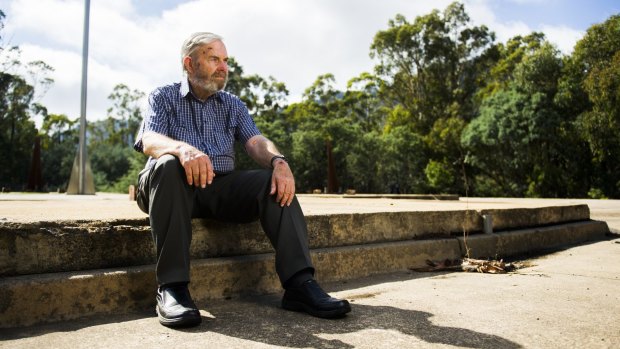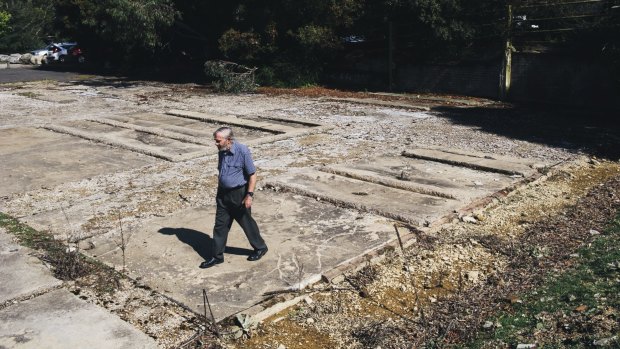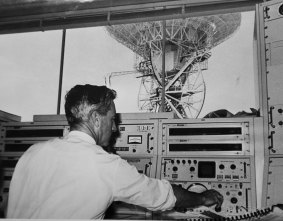By Clare Colley
Almost 49 years since its antenna beamed the first TV images of the moon landing, and 24 years after the site was levelled, the Honeysuckle Creek tracking station has been added to the ACT's heritage register.
The tracking station site, now just concrete footings and explanatory signage in Namadgi National Park, was joined on the heritage list by the similarly-cleared sites of the Orroral Valley tracking station and geodetic observatory nearby.

Former Honeysuckle Creek tracking station employee Hamish Lindsay at the recently heritage-listed site.Credit: Rohan Thomson
The announcement on Friday coincided with the launch of the ACT's five-year heritage strategy.
The Honeysuckle station's former technical support supervisor, photographer and draftsman, Hamish Lindsay, who worked at the NASA-operated site from its beginnings in 1966 until it closed in 1981 praised its inclusion as a heritage site as a way of continuing its story into the future.

All that's left of the antenna site at the Honeysuckle Creek tracking station.Credit: Rohan Thomson
"I was in the team that built the station and I was in the last eight to walk out the door and lock it behind me," he said.
When the site closed in 1981 the station's 26-metre antenna was moved to the Canberra Deep Space Communications Complex at Tidbinbilla before the vandalised buildings were demolished in 1992.
Mr Lindsay said he and other former staff were sad to see the buildings levelled, but in its dangerous state it was for the best.
"We used to gather around when we knew the end was coming and say 'oh we'll make it a golf course, or a cafe or film studio' but of course nothing happened because there was no power here," he said.

Barnard Schrivener at the controls of the antenna at Honeysuckle Creek in 1968.
But Orroral Valley's former senior operations supervisor Philip Clark said he was disappointed the buildings at the two tracking stations weren't preserved.
"Some of the staff won't go back there because it evokes too many painful memories," he said.
"They were just left abandoned, it's terrible… I couldn't really attribute any fault to anybody because I don't think anybody knew what to do."
Mr Clark said both tracking stations were off-grid with their own US-standard power stations during their lives, making it difficult for them to be adapted for other uses.
But heritage listing went some way to keeping the history alive.
"Honeysuckle creek and Tidbinbilla got all the glamour publicity for the big work they were doing, but Orroral Valley which was actually a little bigger and did more tracking was virtually unheard of," Mr Clark said.
"Most of the tracking stations were in Canberra and they were some of the biggest and best in the world."
Planning and Land Management Minister Mick Gentleman said the sites were demolished as the upkeep had been too expensive and vandals had taken over.
"We've kept the heritage story alive both electronically and here on the storyboards," he said.
The Honeysuckle Creek station's significance as a key communication centre for the Apollo 11 moon landing mission was largely forgotten, despite being the antenna that beamed the images of Neil Armstrong taking the first steps on the moon on July 21, 1969.
Mr Lindsay said he suspects Honeysuckle's role was overshadowed by the Australian-owned Parkes dish because it was a NASA station.
The ACT government is seeking community input into the Heritage Strategy to recognise, protect, conserve and promote heritage places and objects in the ACT and ensure the territory's story is kept alive, Mr Gentleman said.
"Sometimes there's a fear it [heritage listing] can impede on progress going forward for development in those cases we want to ensure the community has a good awareness of some of the conditions of building in those areas," he said.
While watching the moon walk was a highlight of Mr Lindsay's life, he and fellow staff felt the Apollo Eight mission – the first manned spacecraft to reach the Moon's orbit was equally as important.
"It was a very frightening mission because we didn't know what was going to happen to anybody who went out there," he said.
The heritage discussion paper and details about information sessions on February 23 and 24 are available at www.haveyoursay.planning.act.gov.au. Public comment will close at 9am Tuesday March 29.